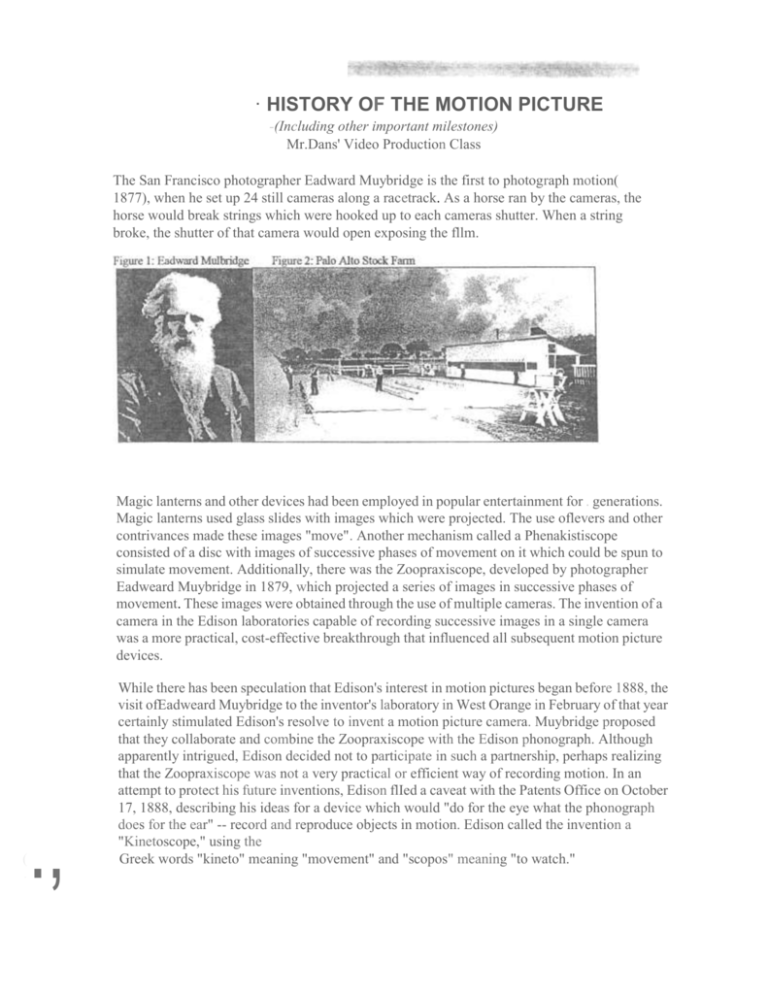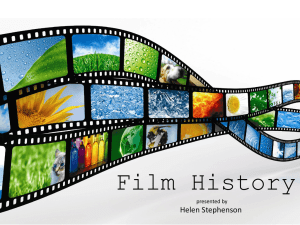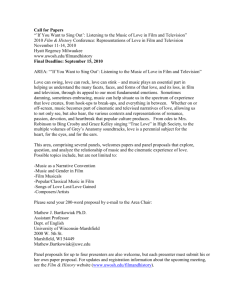History of Cinema - Pleasantville High School
advertisement

· HISTORY OF THE MOTION PICTURE -(Including other important milestones) Mr.Dans' Video Production Class The San Francisco photographer Eadward Muybridge is the first to photograph motion( 1877), when he set up 24 still cameras along a racetrack. As a horse ran by the cameras, the horse would break strings which were hooked up to each cameras shutter. When a string broke, the shutter of that camera would open exposing the fllm. Magic lanterns and other devices had been employed in popular entertainment for . generations. Magic lanterns used glass slides with images which were projected. The use oflevers and other contrivances made these images "move". Another mechanism called a Phenakistiscope consisted of a disc with images of successive phases of movement on it which could be spun to simulate movement. Additionally, there was the Zoopraxiscope, developed by photographer Eadweard Muybridge in 1879, which projected a series of images in successive phases of movement. These images were obtained through the use of multiple cameras. The invention of a camera in the Edison laboratories capable of recording successive images in a single camera was a more practical, cost-effective breakthrough that influenced all subsequent motion picture devices. ( . ., While there has been speculation that Edison's interest in motion pictures began before 1888, the visit ofEadweard Muybridge to the inventor's laboratory in West Orange in February of that year certainly stimulated Edison's resolve to invent a motion picture camera. Muybridge proposed that they collaborate and combine the Zoopraxiscope with the Edison phonograph. Although apparently intrigued, Edison decided not to participate in such a partnership, perhaps realizing that the Zoopraxiscope was not a very practical or efficient way of recording motion. In an attempt to protect his future inventions, Edison flIed a caveat with the Patents Office on October 17, 1888, describing his ideas for a device which would "do for the eye what the phonograph does for the ear" -- record and reproduce objects in motion. Edison called the invention a "Kinetoscope," using the Greek words "kineto" meaning "movement" and "scopos" meaning "to watch." 1. r:~ ~- Edison's assistant, William Kennedy Laurie Dickson, was given the task of inventing the device in June 1889, possibly because of his background as a photographer. Charles A. Brown was made Dickson's assistant. There has been some argument about how much Edison himself contributed to the invention of the motion picture camera. While Edison seems to have conceived the idea and initiated the experiments, Dickson apparently performed the bulk of the experimentation, le~ding most modem scholars to assign Dickson with the major credit for turning the concept into a practical reality. The Edison laboratory, though, worked as a collaborative organization. Laboratory assistants were assigned to work on many projects while Edison supervised and involved himself and , participated to varying degrees. Ultimately, Ed~son made the important decisions, and, as the "Wizard of West Orange," took sole credit for the products of his laboratory. ,. The initial experiments on the Kinetograph were based on Edison's conception of the phonograph cylinder. Tiny photographic images were affixed in sequence to a cylinder, with the idea that when the cylinder was rotated the illusion of motion would be . . reproduced via reflected light. This ultimately proved to be impractical. . The work of others in the field soon prompted Edison and his staff to move in a different direction. In Europe Edison had met French physiologist Etienne-Jules Marey who used a continuous roll of film in his Chronophotographe to produce a sequence of still images, but the lack of film rolls of sufficient length and durability for use in a motion picture device delayed the inventive process. This dilemma was aided when John Carbutt developed emulsion-coated celluloid film sheets, which began to be used in the Edison experiments. The Eastman Company later produced its own celluloid film which Dickson soon bought in large quantities. By 1890, Dickson was joined by a new assistant, William Heise, and the two began to develop a machine that exposed a strip of film in a horizontal- feed mechanism. A prototype for the Kinetoscope was finally shown to a convention of the National Federation of Women's Clubs on May 20, 1891. The device was both a camera and a peep-hole viewer, and the film used was 18mm wide. According to David Robinson who describes the Kinetoscope in his book, From Peep Show to Palace: The Birth of American Film, the film "ran horizontally between two spools, at continuous speed. A rapidly moving shutter gave intermittent exposures when the apparatus was used as a camera, and intermittent glimpses of the positive print when it was used as a viewer-when the spectator looked through the same aperture that housed the camera lens. " !-.J 2. 3. 4. 5. (~ A p1atent for the Kinetograph (the camera) and the Kinetoscope (the viewer) was filed on August 24, 1891. . In this patent, the width of the film was ': specified as 35mm, and allowance was made for the possible use of a cylinder. The Kinetoscope was apparently completed by 1892. David Robinson writes: It consisted of an upright wooden cabinet, 18 in. x 27 in. x 4 ft. high, with a peephole with magnifying lenses in the top .. .Inside the box the film, in a continuous band of approximately_ 5_0 _ feet, was arranged around a series of spools. A large, electrically driven sprocket wheel at the top of the box engaged corresponding sprocket holes punched in the edges of the film, which was thus drawn under the lens at a continuous rate. Beneath the film was an electric lamp, ~d between the lamp and the film a revolving shutter with a narrow slit. As each frame passed under the lens, the shutter permitted a flash of light so brief that the frame . appeared to be frozen. This rapid series of apparently still frames appeared, thanks to the persistence of vision phenomenon, as a moving image. (From Peep Show to Palace, p. 34) At this point, the horizontal-feed system had been changed to one in which the film was fed vertically. The ~iewer would look into a peep-hole at the top of the cabinet in order to see the image move. The first public demonstration of the Kinetoscope was held at the Brooklyn Institute of Arts and Sciences on May 9, 1893. The Frenchman Louis Lumiere is sometimes credited as the inventor of the motion picture camera in 1895'. Other inventors preceded him, and Lumiere's achievement should always be considered in the context of this creative period. Lumiere's portable, suitcasesized cinematographe served as a camera, film processing unit, and projector all in one. Re could shoot footage in the morning, process it in the afternoon, and then project it to an audience that evening. His first film was the arrival of the express train at Ciotat. Other subjects included workers leaving the factory gates, a child being fed by his parents, people enjoying a picnic along a river. The ease of use and portability of his device soon made it the rage in France. Cinematographes soon were in the hands of Lumiere followers all over the world, and the motion picture era began. The American Thomas Alva Edison was a competitor ofLumiere1s, and his invention predated Lumiere's. But Edison's motion picture camera was bulky and not portable. The "promoter" in Lumiere made the difference in this competition. For a good description of these historical developments, read Erik Barnouw's Documentary: A History of the NonFiction Film, 2nd revised edition, New York: Oxford Univ. Press, 1993. Although the technology for making movies was invented in 1895, a significant realization of the potential for film as art occurs with the appareance ofD. W. Griffith's 1915 full-length epic, Birth of a Nation. In,this film Griffith utilized crosscutting (parallel editing) effectively, particularly at the climax, when a number of editing tracks playoff one another. He also portrayed battle scenes magnificently, with action ip one set of shots moving from left to right, while action in another set of shots moves from right . to left. But Griffith's work is diminished severely by the overt racism employed in characterizations and plotting and the positive portrayal of the Ku Klux Klan. As a sidelight, readers interested in films about Griffith should check Good Morning, Babylon (1987), directed by the Taviani brothers. It tells the story of two Italian immigrants who become carpenters on the set of Griffith's epic film Intolerance (1916). The English actor Charles Dance plays Griffith. Other well-known Griffith melodramas include Broken . ~!g~~o.~~ (1~19) an4 Way Dow,!_Ea.s! (1?-20). Figure 6: Original movie marquee promotional poster for The Jazz Singer (1927). Warner Bros.' and director Alan Crosland's The Jazz Singer (1927) is an historic milestone film and cinematic landmark. [Most people associate this film with the advent of sound pictures, although Don Juan (1926), a John Barrymore silent film, also had a synchronized score and sound effects.) i Although it was not the first Vita phone (sound-on-disk) feature, it was the first feature-length Hollywood "talkie" film in which spoken dialogue was used as part of the dramatic action. It is, however, only part-talkie (25%) with sound-synchronized, vocal musical numbers and aC,companiment. [The first "all-talking" (or all-dialogue) feature picture was Warners' experimental entry the gangster film Lights of New York (1928).] The commercialization of sound-on-film, a'nd the transformation of the industry from silent films to talkies became a reality with the success of this film. In fact, Jolson's next part-talkie follow-up film, Warners' and director Lloyd Bacon's The Singing Fool (1928), was an even greater hit and a superior film. Fig.7 (top): A special inVitation for the demonstration of a "new" , process called cinemascope. Figs. 8 & 9 (above and right): Theaters advertised the word "Cinemascope" sometimes using greater impact than the actual movie title. 6. The introduction of CinemaScope was a critically important event in mm history. It was the first viable weapon in the effort to get audiences back into theatres. Seen above is the special CinemaScope marquee mounted at the front of the courtyard at Grauman's Chinese Theatre in Hollywood. Figure 10 (right): Original movie marquee poster For the movie "The Robe" I l:~ IIIII1IHIA S_~'\llflllUf1JIHIlIlIAll !1m t~f'~:i~DuIIl. ~~~; ';;71-t-i-!;;jg~nfij 8. 7. 10. 9. I Fig.ll: A squeezed frame from The Robe which used the full 1.33:1 silent fIlm a pertu re size ri , Fig. 12: The same frame projected. This picture was photographed from the screen in a preview at 20th Century-Fox. The slight curvature of the 'Miracle Mirror screen is evident. The projected aspect ratio was 2.66:1 One of the earliest, and best, examples of CinemaScope, Walt Disney's 20,000 Leagues Under The Sea (1954). The illustration below (figure 13) shows the four magnetic soundtracks. With the addition of sound on the picture fIlm, CinemaScope's original 2.66:1 aspect ratio was reduced to 2.55:1. The squarer "FoxHole" sprocket holes were used to allow for slightly wider magnetic stripes than the conventional Kodak or Bell & Howell sprocket holes would allow. The narrow track carried the effects channel sound. Control tones turned the auditorium amplifiers on and off as required because the narrow track tended to be "hissy" when no sound was present. ( ') gure 13: A section of film from 20,000 Leagues Under The Sea, 1954 , Figure 14 (below): Original theatrical marquee poster F i History Of Television Television was not invented by a single inventor, instead many people working together and alone,' contributed to the evolution of TV. ' 1831: Joseph Henry's and Michael Faraday's work with electromagnetism makes possible the era of electronic communication to begin. 1862: Abbe Giovanna Caselli invents his "pantelegraph" and becomes the first person to transl1)it a still image over wires. 1873: Scientists May and Smith experiment with selenium and light, this opens the door for inventors to transform images into electronic signals. 1876: Boston civil servant George Carey was thinking about complete television systems and in 1877 he put forward drawings for what he called a "selenium camera" that would allow people to "see by electricity." Eugen Goldstein coins the term "cathode rays" to describe the light emitted when an electric current was forced through a vacuum tube. Late 1870's: Scientists and engineers like Paiva, Figuier, and Senlecq were suggesting alternative designs for "telectroscopes." 1880: Inventors like Bell and Edison theorize about telephone devices that transmit image as well as sound. Bell's photophone used light to transmit sound and he wanted to advance his device for image sending. George Carey builds a rudimentary system with light-sensitive cells. 12. 11. ages over wires using a rotating metal disk technology calling it the "electric telescope" with 18 lines of resolution. 1900: At the World's Fair in Paris, the 1st International Congress of Electricity was held, where Russian, Constantin Perskyi made the first known use of the word "television. " I Soon after, the momentum shifted from ideas and discussions to physical development of TV systems. Two paths were followed: 13. Mechanical television - based on Nipkow's rotating disks, and 1. Electronic television - based on the cathode ray tube work done independently in 1907 by English inventor A.A. Campbell-Swinton and Russian scientist Boris Rosing. 1906: Lee de Forestinvents the "Audion" vacuum tube that proved essential to electronics. The Audion was the first tube with the ablity to amplify signals. Boris Rosing combines Nipkow's disk and a cathode ray tube and builds the first working' mechanicallY system. (" I 1 8 8 4 : P a u l N i p k o w s e n d s i m 1907: Campbell Swinton and Boris Rosing suggest using cathode ray tubes to transmit images - independent of each other, they both develop electronic scanning methods of reproducing images. American Charles Jenkins and Scotsman John Baird followed the mechanical model while Philo Farnsworth, working independently in San Francisco, and . Russian emigre Vladimir Zworkin, working for Westinghouse and later ReA, advanced the electronic model. 1923: Vladimir Zworykin patents his iconscope a TV camera tube based on Campbell Swinton's ideas. The iconscope, which he called an "electric eye" becomes the cornerstone for further television development. He later develops the kinescope for picture display. 1924 - 1925: American Charles Jenkins and John Baird from Scotland, each demonstrate the mechanical transmissions of images over wire circuits. Photo Left: Jenkin's Radiovisor Model 100 circa 1931, sold as a kit. Baird becomes the first person to transmit moving silhouette images using a mechanical system based on Nipkow's disk (fig.1S left). Vladimir Zworykinpatents a colorelevision system. 1926: John Baird operates a 30 lines of resolution system at S frames per second. 1927: Bell Telephone and the U.S. Department of Commerce conduct the first long distance use of TV, between Washington D.C. and New York City on April 9th. Secretary of Commerce Herbert Hoover commented, "Today we have, in a sense, the transmission of sight for the first time in the world's history. Human genius has now 14. 15. destroyed the impediment of distance in a new respect, and in a manner hitherto unknown." Philo Farnsworth files for a patent on the first complete electronic television system, which he called the Image Dissector. 1928: The Federal Radio Commission issues the first television license (W3XK) to Charles Jenkins. 1929: Vladimir Zworykin demonstrates the first practical electronic system for both the transmission and reception of images using his new kinescope tube. John Baird opens the first TV studio, however, the image quality was poor. 1930: Charles Jenkins broadcasts the first TV commercial. The BSC begins regular TV transmissions. 1933: Iowa State University (W9XK) starts broadcasting twice weekly television programs in cooperation with radio station WSUI. 1936: About 200 hundred television sets are in use world-wide. The introduction of coaxial cable, which is a pure copper or copper-coated wire surrounded by insulation and an aluminum covering. These cables were arid are used to transmit television, telephone and data signals. The 1st "experimental" coaxial cable lines were laid by AT&T between New York and Philadelphia in 1936. The first "regular" installation connected Minneapolis and Stevens Point, WI in 1941. The original L1 coaxial-cable system could carry 480 telephone conversations or one television program. By the 1970's, L5 systems could carry 132,000 calls or more than 200 television programs. 1937: CBS begins TV development. The BBC begins high definition broadcasts in London. Brothers and Stanford researchers Russell and Sigurd Varian introduced the Klystron in. A Klystron is a high-frequency amplifier for generating microwaves. It is considered the technology that makes UHF-TV possible because it gives the ability to generate the high power required in this spectrum. 1939: Vladimir Zworykin and RCA conduct experimentally broadcasts from the Empire State Building. Television was demonstrated at the New York World's Fair and the San Francisco Golden Gate International Exposition. ReA's David Sarnoff used his company's exhibit at the 1939 World's Fair as a showcase for the 1st Presidential speech (Roosevelt) on television and to introduce RCA's new line of television receivers some of which had to be coupled with a radio if you wanted to hear sound. The Dumont company starts making tv sets. 1941: The FCC releases the NTSC standard for black and white TV. 1943: Vladimir Zworykin developed a better camera ube - the Orthicon. The Orthicon (fig.16 Left) had enough light sensitivity to record outdoor events at oldmark, working for CBS, demonstrated, his color television system to the FCC. His system produced color pictures by having a red-blue-green wheel spin in front of a cathode ray tube. This mechanical means Of producing a color picture was used in 1949 to broadcast medical procedures from Pennsylvania and Atlantic City hospitals. In Atlantic City, viewers could come to the convention center to see broadcasts of operations. Reports from the time noted that the realism of seeing surgery in color caused more than a few viewers to faint. Although Goldmark's mechanical system was eventually replaced by an electronic system he is recognized as the first to introduce a broadcasting color television system. 1948: Cable television is introduced in Pennsylvania as a means of bringing television to rural areas. A patent was granted to Louis W. Parker for a low-cost television receiver. One million homes in the United States have television sets. 1950: The FCC approves the first color television standard which is replaced by a second in 1953. Vladimir Zworykin developed a better camera tube - the Vidicon. __ .-!_9~6=-.~mp_~x intr:oduqt~_ tbe_ fLrsLpracticaL videotape_system of broadcast quality. 1956: Robert Adler invents the first practical remote control called the Zenith Space Commander, proceeded by wired remotes and units that failed in sunlight. '1, 19 46 : P et er G 1962: The All Channel Receiver Act requires that UHF tuners (channels 14 to 83) be included in all sets. ' 0 1962: AT&T launches Telstar, the first satellite to carry TV broadcasts broadcasts , are now internationally relayed. r ( ) 1997-1999: Electronic manufacturers begin abandoning the laserdisc format with Pioneer being the last company to support it with only one combination DVDLaserdisc paler. 2000 - present: the popularity of HDTV increases. Some sets are EDTV and do not supply true HDTV's full resolution of 720p and 1080i.







